Razer Tiamat 7.1 True Surround Sound Headset Review
Tim Mammatt / 12 years ago
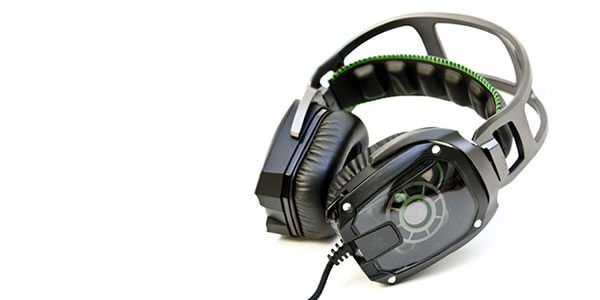
Razer are a well established gaming peripherals brand that is incredibly popular across the globe. With product ranges including gaming mice, keyboards, speakers, headsets and even gaming laptops, Razer cover all the bases with high performing and top quality peripherals. We’ve seen several of their products here before at eTeknix.com, and with no surprise the majority of them walked away clutching an award. Will this be the case with their newest headset that we have in today? Lets find out.
Headsets are a very important component for the full, immersed gaming, studio or cinema experience and there are many companies out there that claim they provide the full experience. This isn’t always the case though, as a lot of the time cheap headsets are given a facelift, and have “gaming” slapped in the name, hiking the price up another £20 or so, for comparatively a lot less. Then there is also the debate over the best kind of surround sound – virtual or true. Today Razer have provided us with their Tiamat 7.1 True Surround Sound headset, so we hope to address some of the issues.
The Razer Tiamat is the company’s first true 7.1 surround sound headset, which they even boast as the “World’s first true 7.1 headset”. Could cramming 10 drivers into the headset reduce the depth and quality of the sound? There is only way to find out… read on
Before we take a look at the headset, lets just take a quick look at the quick specs of the Razer Tiamat (from Razer’s website).
- True-to-life 7.1 Surround Sound from 10 discrete drivers
- All-in-one volume control unit for multi-channel customization and toggling between headset and speakers
- Comfortable, snug fit for extended play
- Retractable, noise-filtering unidirectional mic
- Interchangeable ear cup covers
- Replaceable soft-touch leatherette ear cushions
- Braided fibre cable
- Approximate Weight: 350 g / 0.77 lbs
When we first unpackaged the Tiamat from the shipping packaging we were surprised at the initial quality of the box. Razer have put a great deal of effort to present you with a simple, yet classy box for the box, so much so it reminded us of how Apple package their products. On the front of the box there is a graphic display of the headset with a few features listed. On the left side there are more features listed with greater detail.
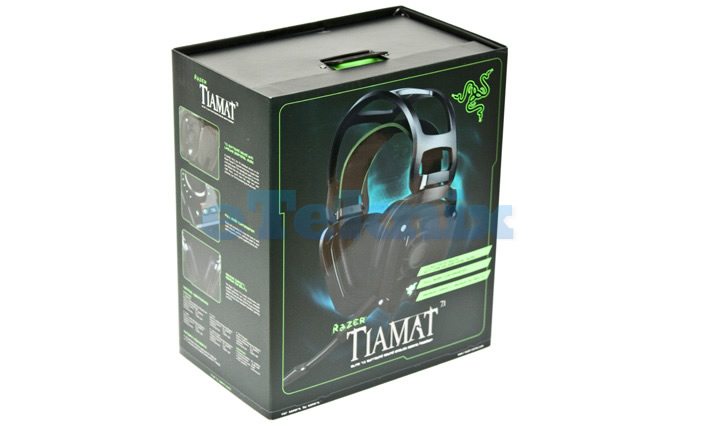
The back of the box has a diagram of the ear cup and details the individual drivers that make up the true 7.1 surround sound headset.
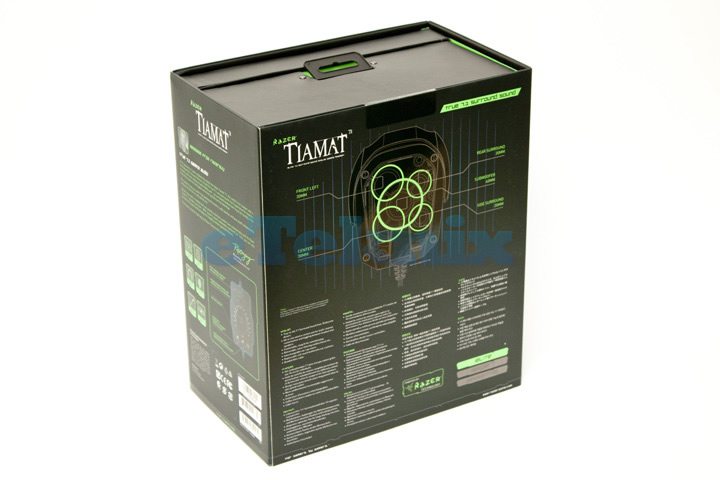
When the outer shell (above) is removed, you are presented with a plain box, that unfolds to display the contents. From here you get the first look at the visually stunning Tiamat headset.
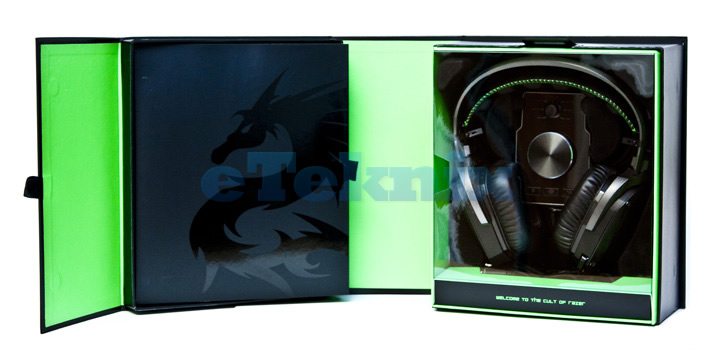
On the left side of there is a piece of card that when opened, reveals the quick start guide, manual, warranty info and the usual stickers. There are also two optional ear cup covers.
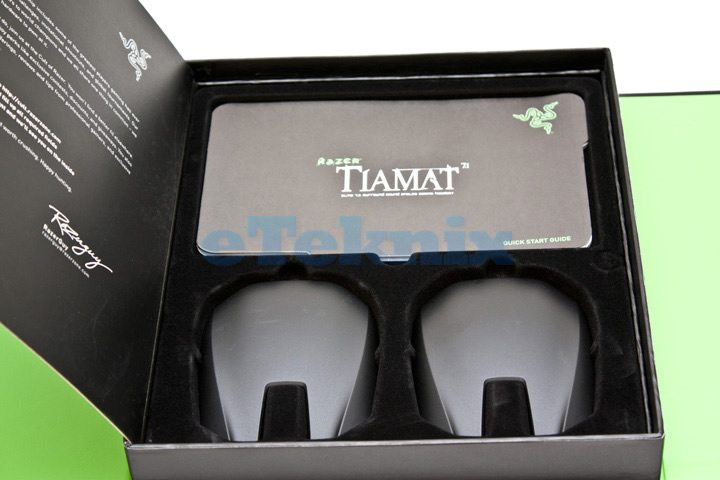
On the right side the headset is displayed in all it’s glory behind a clear plastic cover, surrounded in the Razer green. The inline control unit is shown off between the ear cups.

Take the jump to have a closer look at the Razer Tiamat 7.1.
So here it is, the Razer Tiamat 7.1 headset and the contents of the box mentioned previously. At a first glance the headset looks very impressive, so lets have a closer look.
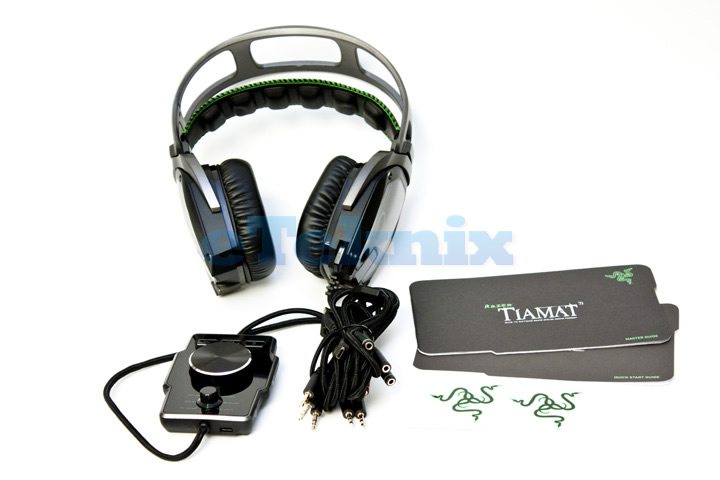
The Razer Tiamat is a very contemporary design, with a metallic frame, clear plastic ear cups and an unusual padded headband style. As per most of Razer’s products, there are subtle Razer green highlights. From first inspection, you can see that the Tiamat is a large headset, probably to fit all those drivers in. The main body of the Tiamat is made of plastic painted in a metallic paint, again, this is probably down to reducing the weight of the headset.

To save on weight, the plastic headband frame has large cut outs. The padded headband it’self is made up of six separate pads rather than one long strip. This is also elasticated so it automatically adjusts to different head sizes.

A rather nice feature about the Tiamat is the clear ear cups, that allows you to see the audio drivers that make this headset so special. The ear cups have some flexibility where they join the main headband, which allows them to rotate slightly. You may also notice four silver discs in each corner of the ear cups, these are small magnets which we’ll talk about in more detail later.

Closer inspection of the left ear cup reveals the noise cancelling microphone. This is fully extendible as you will see in the next photo.
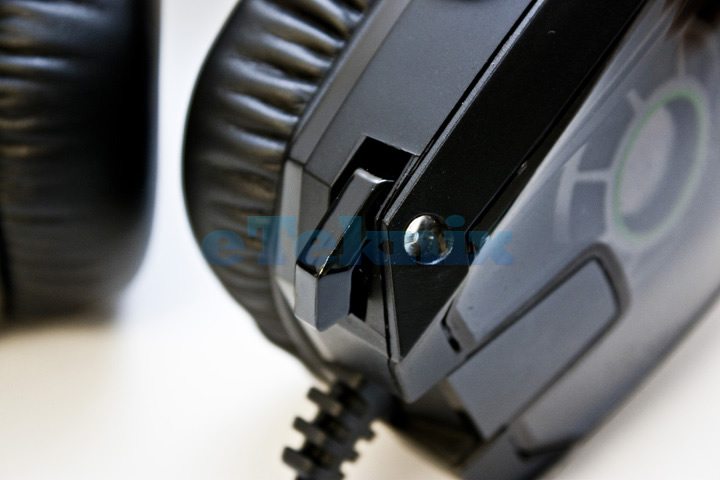
This is the microphone fully extended. The main boom is of a solid construction to allow it to be retracted back into the ear cup, however the mid section is flexible allowing you to bend the microphone into a better position if need be.

The ear cups themselves are faux leather covered foam that covers the whole ear (even large ears). This is to offer better background noise suppression, although it does mean less air getting to your ears, which results in hot ears!
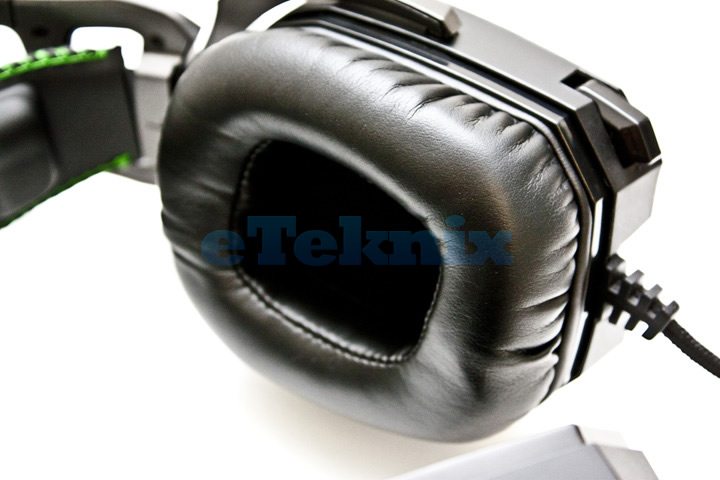
In this photo we removed the ear cup padding to reveal the speakers in the ear cup. There are five in each ear cup, which offer full 7.1 surround sound: two front, two side, two rear, one centre and one sub.

Razer also provide you with ear cup covers for those who wish to cover up the insides of the ear cups. These are held in place by the four small magnets we mentioned earlier.

At the other end of the braided 3m cable there are the 5x 3.5mm jacks, of which at least the red/pink and the green are required (for stereo), although if you want to experience the full potential of the headset, all five will need to be connected for 7.1. The gold plated USB connection is required to power the in-line control system that we will take a look at shortly. 
Near the headset end of the cable is the in-line control system. This is a fairly large unit, but it has a rubber base to stop it sliding around. It features two dials and three buttons, which we’ll go into more detail in the next photograph.

At the top of the control unit, there is a dial that selects the speaker set to adjust the volume to. When selected, the larger dial below it adjusts the volume. The larger dial can also be pressed to mute the selected speaker set.

Below the big dial there are three buttons, mute microphone, change device and select mode (from left to right). The first button is self explanatory (mute mic), the second allows you to switch the audio to you speakers using the additional cable provided. This also supports up to 7.1 surround sound speakers. Finally, the last button lets you switch between stereo and 7.1 – more on this later.

This cable allows you to connect 7.1 surround sound speakers to the control block, so you can switch between the speakers and the headset on the fly by pressing the centre button. This is something we have never seen before, but is a great feature – now you no longer have to faff about round the back of the PC to disconnect the cables.

So, that concludes our first look at the Razer Tiamat, now lets put it to the test.
The Razer Tiamat requires a 7.1 capable soundcard in order to receive the full surround sound experience, although it is possible to just use the headset in stereo (just the green audio jack). For the testing, we connected the headset in 7.1 mode to a Asus Maximus IV Gene/Gen 3, using the onboard sound.
Gaming
To check out the performance of the Tiamat during gaming, we fired up Left 4 Dead 2 and Counter Strike: Source because they both support 7.1. Whilst playing Left4Dead 2, the Tiamat’s true surround sound really showed just how good the headset is. It allowed pin-point positioning, which was perfect for spotting an ambush or a boomer hiding around the corner. We found the same whilst playing CS:S – the surround sound made it perfect for locating the enemy giving us the jump on anyone trying to surprise us – so much so, we were often accused of hacking because of all the prefiring we did. We also switched the headset over to stereo mode, that whilst it didn’t provide the exceptional audio positioning abilities the Tiamat had in full 7.1 mode, it still provided some decent positioning. The audio quality was flawless throughout both games, with deep rich bass, crystal audio clarity and decent high, mid and low tones.
Music
Bearing in mind the Razer Tiamat is designed with gaming in mind, we thought we’d just see how well they handled some of our music we blast out in the office. Lets just say the Tiamat can go VERY loud, so much so it’s like using speakers when the volume is set to the max. It reproduced the audio playback just as well as it did for gaming, with lovely deep bass for the dance tracks we often play. One really good feature we liked with the Tiamat is the ability to switch between our speakers and the headset at the push of a button on the control box, instead of having to unplug them – something we haven’t seen on any headsets yet.
Movies
Last up is movies, for this we used our bluray player to watch Transformers 3 which has a 7.1 native audio soundtrack. Would you be surprised if we told you it performed flawlessly and just as well as it did with the gaming tests, if not better? The bass really came into effect with this movie, giving it a great depth and realism. The positioning was spot on, and at moments, it actually sounded like they were in the room.
Mic
We also put the mic to the test by having a conversation using Skype and via Mumble. For Skype, the quality was 555 with either very little or no background hiss thanks to the background cancelling. In Mumble, the codec needed a little tweak, but this was because Mumble can be a pain to set up. The mic mute button was ideal for when someone else came in the room and we wanted to talk to them instead, with just a simple push and the recipient can no longer hear you.
Comfort
Throughout our testing the headset remained comfortable, with no noticeable aches or pains even after a 4 hour gaming session. They sat very well on our heads, although we did feel a little dubious when it came to pulling them placing as we didn’t want to flex the plastic too much in case it snapped, though this was easily overcome.
So this concludes our testing, take the jump to see what we think.

The Razer Tiamat is the world’s first true 7.1 surround sound headset, and boy have Razer set the bar high for any future true 7.1 headsets we may see. The headset oozed quality, not only in looks, but also performance wise. There was no compromise in the depth of the sound or quality of the different tones, which we though we may see from the smaller drivers. For gaming, music, movies and VoIP they performed flawlessly with almost perfect positioning, sometimes making you feel like you were actually there. One of the more noticeable features that we loved is the ability to switch between speaker and headset audio, a simple, yet overlooked issue with most of the headsets on the market.
We tried very hard to find any faults with the Tiamat, so after many, many hours of testing we could only settle on the one, the additional ear cup covers. The reason why we didn’t find these particularly good, was because the magnets that held them in place are not very strong, so when we came to remove the headset, they were often flung across the room as they were grabbed instead. This is just a very minor issue, which can be rectified by keeping them off altogether and to display the attractive interior instead.
The Tiamat comes in at £159.98 in the UK, which some may see as quite a hit to the wallet, but you are getting a great deal for your money – the worlds first 7.1 true surround sound headset that looks stunning and performs great!
Razer have set very high standards with the Tiamat, which easily exceeds the majority of headsets on the market, in both sound quality and visual appeal. We cannot find any negative points with the headset other than the weak magnets, but still, we applaud Razer for allowing the users the option to customise the look. With so many features crammed in, and all of exceptional performance, we can think of nothing better than to award the Razer Tiamat 7.1 with our most prestigious award. These are now officially our favourite headset.




















